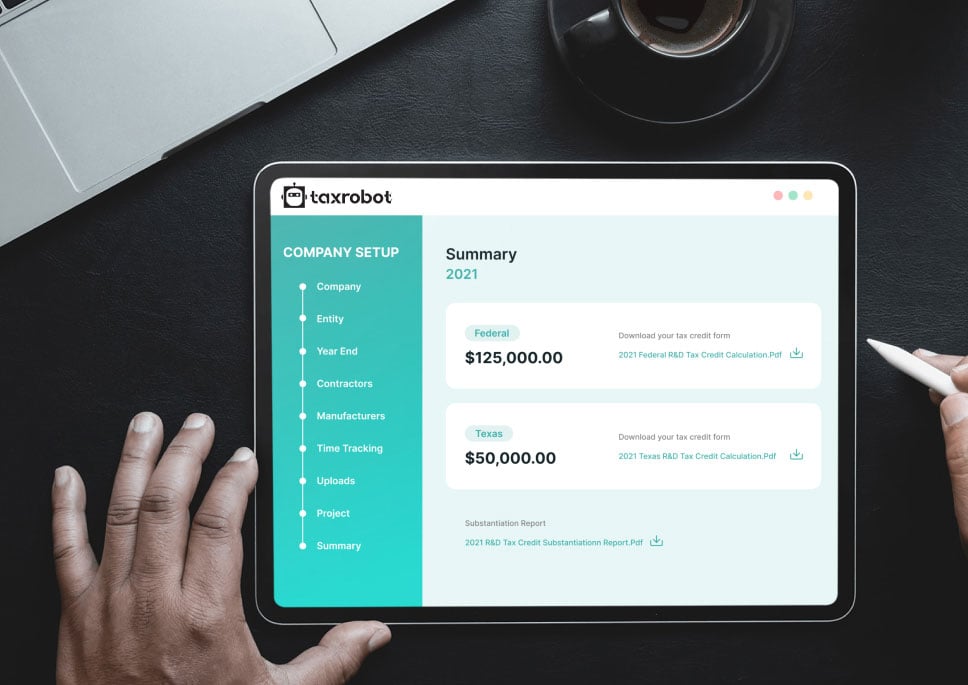Massachusetts R&D Credit
Get the most out of your Massachusetts R&D credit with TaxRobot.
Maximize your State Credits today!
Put the R&D tax credit process on autopilot.
Trusted By:








Massachusetts R&D Credit
Discover your eligibility for Massachusetts R&D tax credits and supercharge your enterprise.
Are There R&D Credits in Massachusetts?
Yes, there are R&D credits available in Massachusetts from both the federal and state governments. The state’s research credit mirrors the federal one closely, making it relatively simple to qualify and apply for both.
Massachusetts Research Credit
The Massachusetts research credit has many similarities to the federal credit, though a few key differences remain. It is calculated by adding the sum of two groups of expenses. These are 15% of the incremental basic research expenses and 10% of the incremental QREs. Because the credit mirrors IRS Section 41, it also requires three years of previous expenses to calculate the amount of the credit.
A new alternative simplified method allows businesses to claim 10% of the taxpayer’s qualified research expenses that are in excess of 50% of the average QREs for the prior three tax years.
You can still qualify for the credit if you didn’t have qualifying expenses for one of the previous three tax years. In this case, your credit would be 5% of your QREs for the taxable year.
The credit is capped at 100% of a corporation’s first $25,000 of corporate excise tax liability and 75% of the liability exceeding this. The minimum tax cannot be reduced below $456. Credits exceeding these limitations can either be carried over to future tax years or applied against the corporate excise tax.
Federal R&D Tax Credit
The federal R&D tax credit is quite similar to the Massachusetts credit. Since one of the requirements is that the business must meet the requirements of Section 41, businesses that qualify for one should qualify for the other. In total, businesses may expect to receive a credit totaling between 6-8% of their qualified research expenses.
How to Qualify for the Massachusetts R&D Credit
The deadline for the Massachusetts R&D credit is the state tax return due date. You’ll need to file Schedule RC. In addition, you’ll need to keep gross receipts and documents for the previous four tax years.
Your Business
Massachusetts is more lenient when it comes to which businesses may qualify for the credit compared to some states. Both C and S corporations are eligible. However, unincorporated flow-through entities are also eligible.
Your Expenses
Qualified expenses that can be claimed towards the credit are those that directly impact R&D activities in the state. These are outlined by IRC section 41. Eligible expenses include wages for qualified services and expenses for supplies and raw materials used for research in Massachusetts. It can also apply to computer equipment and the right to use computers if they are treated as in-house research expenses. Finally, 65% of the amount paid to contractors for research conducted at a research facility in the state qualifies as well.
Make Claiming the Massachusetts R&D Credit Easier with TaxRobot
While the Massachusetts R&D credit is simpler than the credits some other states offer, it’s still confusing to some people. This can be made even more confusing since there are a few key differences between the state and federal credits.
If you want to make claiming both R&D credits easier, TaxRobot can help. Not only will our software help ensure you’re applying for as much of the credit as you are eligible for, but we’ll also support you even after you file. We have audit-proof documentation and audit defense, so you never need to worry about making a mistake and paying for it later. We even offer consultations if you need additional expertise.
See How Much You Could Save
Curious just how much the R&D credit could total up to? Use our calculator to see just how much you could be saving by claiming the Massachusetts R&D credit.
Take a sneak peak

- Limited Time Offer
- Simple Onboarding
- Easy to Use
R&D Tax Credits FAQs
The four-part test as outlined in the Internal Revenue Code is used to determine qualified R&D activity.
The Four-Part Test
1). New Or Improved Business Component
Creation of a new product, process, formula, invention, software, or technique; or improving the performance, functionality, quality, or reliability of existing business component.
- Construction of new buildings or renovation of existing buildings
- Invention of a software application
- Manufacturing of a new product or the improvement of the production process for an existing product
- Creation of design documentation
2). Technological In Nature
The activity fundamentally relies on principles of the physical or biological sciences, engineering, or computer science. A taxpayer does not need to obtain information that exceeds, expands or refines the common knowledge of skilled professionals in a particular field.
- Physics (relationship between mass, density and volume; loading as the
result of gravitational attraction) - Engineering (mechanical, electrical, civil, chemical)
- Computer science (theory of computation and design of computational systems)
3). Elimination Of Uncertainty
Uncertainty exists if the information available to the taxpayer does not establish the capability or method for developing or improving the business component, or the appropriate design of the business component.
- The capability of a manufacturer to create a part within the specified tolerances
- The appropriate method of overcoming unsuitable soil conditions during construction
- The appropriate software design to meet quality and volatility requirements
4). Process Of Experimentation
A process designed to evaluate one or more alternatives to achieve a result where the capability or method of achieving that result, or the appropriate design of that result, is uncertain as of the beginning of the taxpayer’s research activities.
- Systematic process of trial and error
- Evaluating alternative means and methods
- Computer modeling or simulation Prototyping Testing
The R&D tax credit is one of the most misunderstood tax incentives available. Considering the myriad of industries and activities that legally qualify for the credit, the term “research and development” is a misnomer. Additionally, the R&D tax credit requires specialized knowledge and technology to identify and calculate the incentive properly.
Companies of various industries are unaware that they are eligible to claim the R&D tax credit. Under the Internal Revenue Code’s definition of R&D, many common activities qualify. You can get tax benefits for industries including software, technology, architecture, engineering, construction, manufacturing, and more.
The R&D tax credit can be claimed for all open tax years. Generally, open tax years include the prior three tax years due to the statute of limitations period. In certain circumstances, the law allows businesses to claim the R&D tax credit for an extended period of time. It is common for companies to amend previous tax years to claim this benefit and reduce the maximum amount of tax liability.
Partnerships and S corporations must file this form to claim the credit. The credit will flow from the Form 6765, to the Schedule K-1, to the Form 3800 on the individual’s tax return. For individuals receiving this credit that have ownership interest in a partnership or S corporation, Form 6765 is not required on the individual return.
Individuals claiming this credit can report the credit directly on Form 3800, General Business Credit if their only source for the credit is a partnership, S corporation, estate, or trust. Otherwise, Form 6765 must be filed with the individual’s tax return (e.g. sole proprietorship).
For tax years prior to 2016, the credit can be used to reduce the taxpayer’s regular tax liability down to the tentative minimum tax. The credit cannot be used to offset alternative minimum tax. Beginning in tax year 2016, eligible small businesses have expanded utilization for the credit. For these eligible small businesses, the regular tax liability can offset alternative minimum tax using the “25/25” rule.
What our customers have to say
I highly recommend TaxRobot to anyone considering an R&D Tax Credit software to complete their analysis.

We decided to switch to TaxRobot… Best decision we’ve ever made. More affordable, and less complicated.

I couldn’t believe how easy it was! In under an hour, we saved enough money to hire a new employee.
